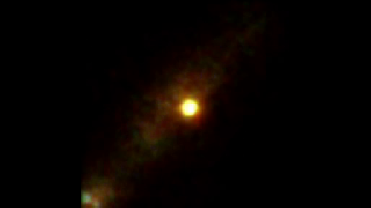
In this photo, released by NASA, pulsed gamma rays from the Vela pulsar as constructed from photons detected by Fermi's Large Area Telescope can be seen.
WASHINGTON (BNS): Astronomers have been able to study gamma-rays emitted by pulsars discovered by NASA’s Fermi Gamma-ray Space Telescope.
According to studies published in the latest edition of Science Express, international teams of scientists have analyzed gamma-rays from two dozen pulsars, including 16 discovered by Fermi.
A pulsar is the rapidly spinning and highly magnetized core left behind when a massive star explodes. Most of the 1,800 cataloged pulsars were found through their periodic radio emissions. Astronomers believe these pulses are caused by narrow, lighthouse-like radio beams emanating from the pulsar's magnetic poles.
“Fermi has truly unprecedented power for discovering and studying gamma-ray pulsars. Since the demise of the Compton Gamma Ray Observatory a decade ago, we've wondered about the nature of unidentified gamma-ray sources it detected in our galaxy. These studies from Fermi lift the veil on many of them,” said Paul Ray of the Naval Research Laboratory in Washington.
According to NASA, Fermi is the first spacecraft able to identify pulsars by their gamma-ray emission alone.
The Vela pulsar, which spins 11 times a second, is the brightest persistent source of gamma rays in the sky. Yet gamma rays – the most energetic form of light – are few and far between. Even Fermi's Large Area Telescope sees only about one gamma-ray photon from Vela every two minutes.
“That's about one photon for every thousand Vela rotations,” said Marcus Ziegler, a member of the team reporting on the new pulsars at the University of California, Santa Cruz. “From the faintest pulsar we studied, we see only two gamma-ray photons a day.”
Radio telescopes on Earth can detect a pulsar easily only if one of the narrow radio beams happens to swing our way. If not, the pulsar can remain hidden, NASA said in a release.
A pulsar's radio beams represent only a few parts per million of its total power, whereas its gamma rays account for 10 percent or more. Somehow, pulsars are able to accelerate particles to speeds near that of light. These particles emit a broad beam of gamma rays as they arc along curved magnetic field lines.
The new pulsars were discovered as part of a comprehensive search for periodic gamma-ray fluctuations using five months of Fermi Large Area Telescope data and new computational techniques, NASA said.
Like spinning tops, pulsars slow down as they lose energy. Eventually, they spin too slowly to power their characteristic emissions and then become undetectable.
At rotation periods between 100 and 1,000 times per second, old pulsars can resume the activity of their youth. In the second study, Fermi scientists examined gamma rays from eight of these "born-again" pulsars, all of which were previously discovered at radio wavelengths.
“Before Fermi launched, it wasn't clear that pulsars with millisecond periods could emit gamma rays at all,” said Lucas Guillemot at the Center for Nuclear Studies in Gradignan, near Bordeaux, France. “Now we know they do. It's also clear that, despite their differences, both normal and millisecond pulsars share similar mechanisms for emitting gamma rays.”
The Fermi Gamma-ray Space Telescope is an astrophysics and particle physics partnership, developed in collaboration with the US Department of Energy, along with important contributions from academic institutions and partners in France, Germany, Italy, Japan, Sweden, and the US.
 Previous Article
Previous Article Next Article
Next Article











The Indian Air Force, in its flight trials evaluation report submitted before the Defence Ministry l..
view articleAn insight into the Medium Multi-Role Combat Aircraft competition...
view articleSky enthusiasts can now spot the International Space Station (ISS) commanded by Indian-American astr..
view article